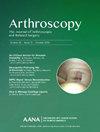Lateral Extra-articular Tenodesis Does Not Decrease Graft Failure in Revision Anterior Cruciate Ligament Reconstruction When Combined With Quadriceps or Patellar Tendon Grafts
IF 4.4
1区 医学
Q1 ORTHOPEDICS
Arthroscopy-The Journal of Arthroscopic and Related Surgery
Pub Date : 2024-10-01
DOI:10.1016/j.arthro.2024.01.034
引用次数: 0
Abstract
Purpose
To compare return-to-sport (RTS) rates, graft failure rates, and clinical outcomes in patients who underwent revision anterior cruciate ligament reconstruction (R-ACLR) with additional lateral extra-articular tenodesis (LET) versus isolated R-ACLR.
Methods
A retrospective review of the medical records of patients who underwent R-ACLR with or without a modified Lemaire LET procedure was performed. Seventy-four patients with at least 2 years of follow-up who had high-grade positive pivot-shift test findings were included. Concomitant procedures such as meniscectomy and meniscal repair were collected, along with any complications and/or graft failure. The Knee Injury and Osteoarthritis Outcome Score (KOOS) and the International Knee Documentation Committee Subjective Knee Form score were collected. The ability to RTS was defined as fully, partially, or not returned.
Results
Of the patients, 39 underwent isolated R-ACLR (mean age ± standard deviation, 29.2 ± 12.2 years) whereas 35 underwent an additional LET procedure (mean age, 24.6 ± 7.4 years). The mean length of follow-up in the R-ACLR group was 56.6 ± 26.5 months compared with 44.3 ± 17.6 months in the R-ACLR–LET group (P = .02) (range, 24-120 months). Patient-reported outcome measures were higher in the R-ACLR–LET group, with the KOOS Activities of Daily Living (93.5 ± 2.0 vs 97.2 ± 1.6, P = .03) and KOOS Sport (63.0 ± 3.6 vs 74.3 ± 3.8, P = .05) subdomain scores reaching the level of statistical significance. No differences were found in the other KOOS subdomain scores or the International Knee Documentation Committee scores. Failure rates were not significantly different between the groups (12.8% for R-ACLR vs 11.4% for R-ACLR–LET, P = .99). There were 13 patients (72.2%) in the R-ACLR group and 14 patients (60.8%) in the R-ACLR–LET group who did not RTS.
Conclusions
R-ACLR with additional LET showed similar failure and RTS rates to isolated R-ACLR after failed ACLR. The R-ACLR–LET group showed better functional results with significantly higher KOOS subdomain scores for activities of daily living, as well as sports and recreation. However, this study was unable to recommend the modified Lemaire LET procedure to be routinely used in R-ACLR patients.
Level of Evidence
Level III, retrospective comparative therapeutic trial.
结合股四头肌或髌骨肌腱移植物时,侧方关节外腱膜切除术不会减少前交叉韧带翻修手术中的移植物失败率。
目的:本研究旨在比较接受前交叉韧带翻修重建术(R-ACLR)和附加外侧关节外腱鞘切除术(LET)的患者与单独接受 R-ACLR 的患者的运动恢复情况、移植物失败率和临床疗效:方法: 对接受 R-ACLR 并同时接受或不接受改良 Lemaire LET 的患者病历进行了回顾性分析。共纳入了74例随访时间≥2年、枢轴移位试验呈高级别阳性的患者。收集了半月板切除术和半月板修复术等伴随手术的并发症和/或移植失败的情况。收集膝关节损伤和骨关节炎结果评分(KOOS)和国际膝关节文献委员会(IKDC)主观膝关节表格。恢复运动能力被定义为完全恢复、部分恢复或未恢复:39名患者接受了孤立的R-ACLR(平均年龄(SD±)29.2±12.2),35名患者接受了额外的LET(24.6±7.4)。R-ACLR 组的平均随访时间为 56.6 ±26.5 个月,而 R-ACLR+LET 组为 44.3 ±17.6 个月(P = 0.02*)(范围为 24 - 120 个月)。LET组的PROMs更高,其中KOOS ADL(93.5 ± 2.0; 97.2 ± 1.6; p=0.03)和KOOS Sport(63.0 ± 3.6; 74.3 ± 3.8; p=0.05)子域达到统计学意义。其他 KOOS 子域或 IKDC 评分未发现其他差异。两组的失败率无明显差异(R-ACLR 为 12.8% vs R-ACLR+LET 为 11.4%;P=0.99)。R-ACLR组有13名(72.2%)患者和R-ACLR+LET组有14名(60.8%)患者没有重返运动场:结论:与前交叉韧带置换术失败后单独进行 R-ACLR 相比,附加 LET 的 R-ACLR 显示出相似的失败率和 RTS。R-ACLR+LET组显示出更好的功能效果,日常生活活动以及运动和娱乐的KOOS子域评分明显更高。不过,本研究无法建议将改良的 Lemaire LET 常规用于前交叉韧带重建患者:证据等级:III,回顾性比较治疗试验。
本文章由计算机程序翻译,如有差异,请以英文原文为准。
求助全文
约1分钟内获得全文
求助全文
来源期刊
CiteScore
9.30
自引率
17.00%
发文量
555
审稿时长
58 days
期刊介绍:
Nowhere is minimally invasive surgery explained better than in Arthroscopy, the leading peer-reviewed journal in the field. Every issue enables you to put into perspective the usefulness of the various emerging arthroscopic techniques. The advantages and disadvantages of these methods -- along with their applications in various situations -- are discussed in relation to their efficiency, efficacy and cost benefit. As a special incentive, paid subscribers also receive access to the journal expanded website.

 求助内容:
求助内容: 应助结果提醒方式:
应助结果提醒方式:


